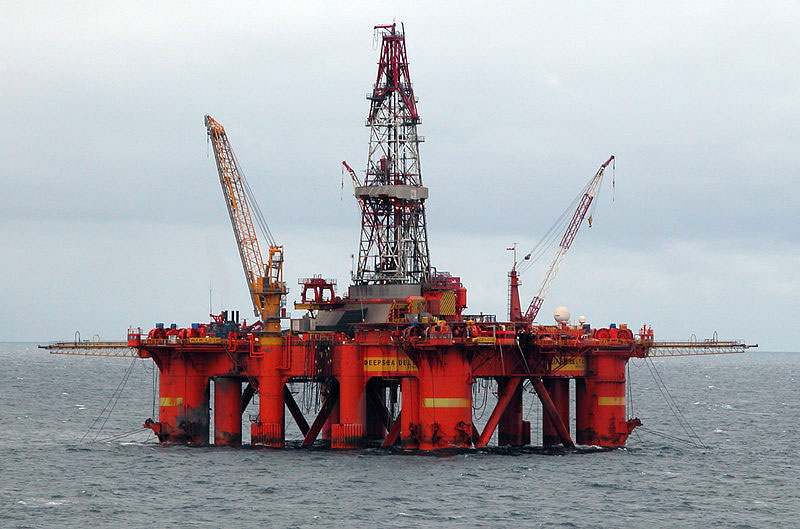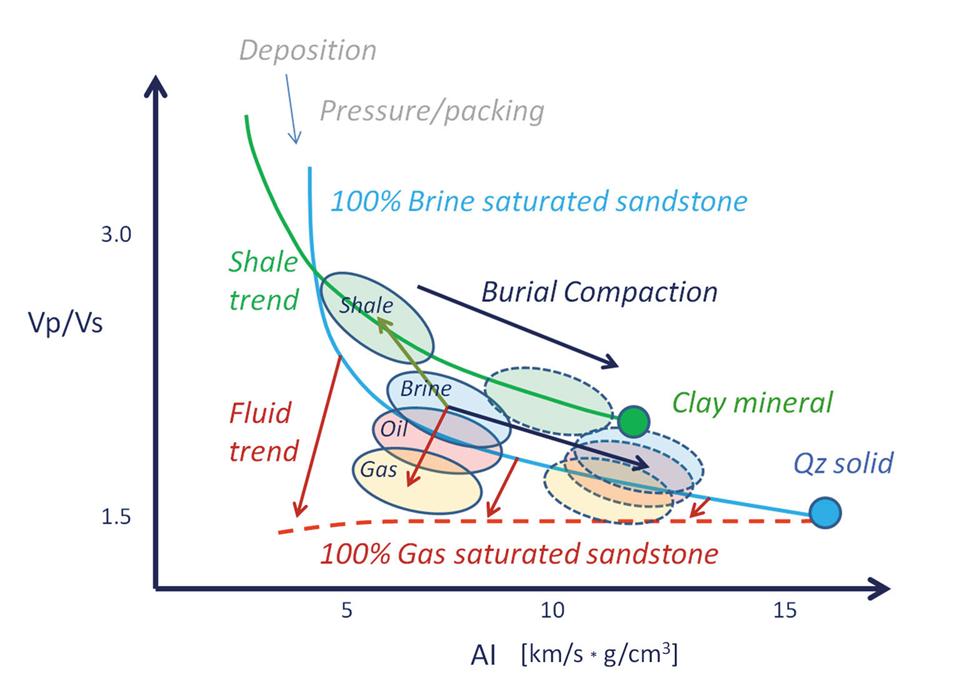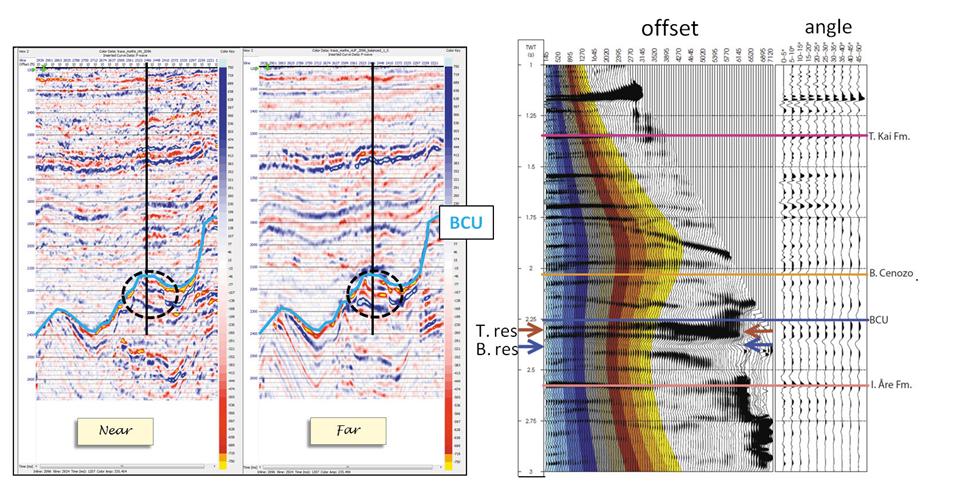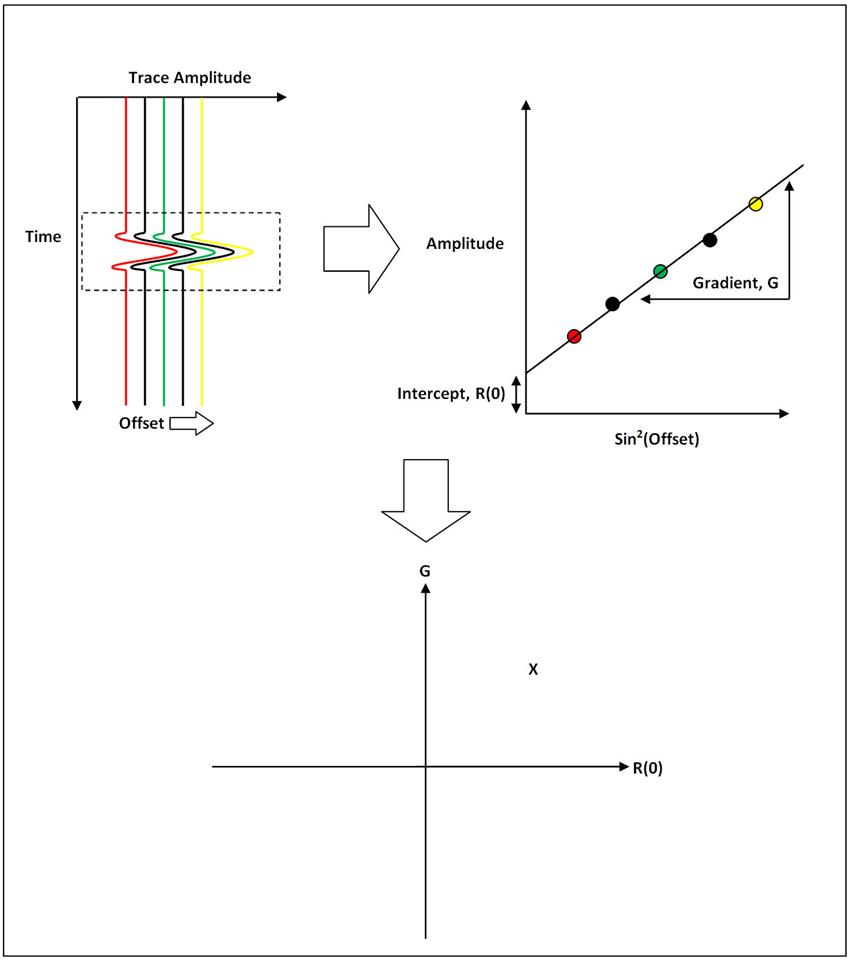Image Description: Figure 3: Fluid impedance estimated from AVO inversion data (left) and rock physics template showing inversion data at the well location 6507/11-8, with same attribute as colour. The hydrocarbon zone around the well is easily detected. Also, we observe some leaked gas in the overburden. (For further explanation, see Avseth and Veggeland, 2015).

Oil platform in the North Sea
How does diagenesis affect rock physics? What is the relationship of the burial history to the rock physics? Both have a dramatic impact on the rock physics properties of not only the reservoir, but also the source and seals. Welcome to an interview with Per Avseth, who discusses rock physics and quantitative seismic interpretation. He also talks with us about how developing an effective rock physics model requires the integration of geological, geophysical, geochemical, and petrophysical information.
What is your name and your experience in the oil industry?
My name is Per Avseth, and I have been working in the oil industry for more than 16 years. I started my career as a seismic interpreter at Norsk Hydro Exploration in Oslo in 1993-94, before I pursued graduate studies at Stanford University where I received my PhD in geophysics in 2000. In 2001, I started at Norsk Hydro Research Center in Bergen, where I worked as a research geophysicist for 5 years. I was consulting for 6 years from 2006-2012, first in my own consulting company (Rock Physics Technology), and later with Odin Petroleum, both in Bergen, Norway. In 2012, I started working with Spring Energy, a small oil exploration company in Oslo. Spring got bought by Tullow Oil in 2013, where I am currently a geophysical adviser. Tullow Oil has decided to exit Norway, and from October this year I will again start consultancy within rock physics and quantitative seismic interpretation. I have also been an adjunct professor in reservoir geophysics at NTNU in Trondheim since 2008.
What are some of the areas that you have focused on in the last 5-6 years?

Figure 1: Schematic illustration of rock physics template used for quantitative interpretation of AVO inversion data. Lithology, compaction and fluid effects will show different trends in a cross-plot of acoustic impedance (AI) versus Vp/Vs, and the template models can be used to better understand and discriminate these effects (Adapted from Avseth and Veggeland, 2015).
The last few years I have been focusing on the link between burial history and rock physics properties of reservoirs, seals and source rocks. I find it intriguing that the rocks have "memory". The elastic properties that we measure today reflect the geologic past. In the Barents Sea, hydrocarbons are discovered in shallow rocks, but these have been buried up to 2 km deeper in the past. There are many unsolved issues: What happens with the seismic signatures of a source rock from immature to mature stage? The competing effects of chemical diagenesis, pore pressure build-up, anisotropy, and hydrocarbon generation makes this a challenging problem. Furthermore, I have been working on rock physics attributes derived from elastic inversion data that better separates fluid and lithology effects. Finally, I have investigated fluid and pressure sensitivity and associated 4D seismic signatures of poorly consolidated reservoirs in the North Sea.
What are some of your most compelling "lessons learned"?
The most important learning lesson for me is that integration and input from other disciplines is the key to successful use of rock physics, whether it is in exploration or in production. If we use seismic inversion and rock physics for reservoir prediction, the results should comply with sequence stratigraphic principles. If we use 4D time shift attributes to predict pressure or fluid changes during production, the results should match with the reservoir engineer's flow simulations. In rock physics we are always faced with the issue of non-uniqueness; by tuning various parameters, we can always make our models match with observations. However, we need to honor the local geology and knowledge from our peers in different disciplines when we constrain our models. Sometimes, though, we need to be aware of different perceptions in different disciplines. One example is the significance of small amounts of quartz cement. Sedimentologists and reservoir engineers may consider 1-2 % as insignificant amounts for reservoir quality and reservoir performance, but this small amount of quartz cement at grain contacts can cause huge increases in rock stiffness and seismic velocities. Also, the fluid and stress sensitivities will be drastically reduced with the first few percents of cement. Several gas and oil discoveries in the world are located at burial depths where chemical diagenesis and cementation has just started, so these are important geological effects to take into account when we do rock physics and quantitative seismic interpretation of these fields.
Which techniques, procedures, and new technologies have made the most difference?

Figure 2: Seismic angle stacks and pre-stack gather at well location where a gas discovery was made. A strong AVO response is observed at the target structure. (Adapted from Avseth et al., 2016).
In the last few years, I think broadband seismic has made the biggest impact to geoscientists working in the oil industry. This technology has opened up for better resolution of our reservoirs from seismic, but it has also laid the basis for more robust AVO inversions and more reliable quantitative interpretations. The combination of broadband seismic and increased computational power has made full-waveform inversions tractable for the industry. Bayesian inversion techniques have made it easy and fast to integrate different types of data, for instance seismic and CSEM. In rock physics, the biggest leap the last decade has been within computational rock physics, where rock and flow properties for a given microstructure can be simulated based on a few thin-sections, where various "what-if" scenarios can easily be tested without abundant core sampling. On a different scale, the use of rock-physics templates in quantitative interpretation has become a nifty and popular tool for practitioners in the industry, as the rock physics "tool-box" has become available to a wider group of geo-practitioners, not only to the rock-physics experts.
What do you see as the main challenges right now that could be impeding progress in developing new technologies or encountering "break-through" science?

Methodology for AVO Crossplot.
The obvious hurdle right now is the oil market situation. Unfortunately, research and innovations are suffering more than anything else from budget cuts, even though these at the end can contribute to cost reduction. With increasing climate awareness, there is also a lot of negative focus in the media regarding the future of the oil industry. Hence, the brightest students will not necessarily find the oil industry attractive for their future career. The paradox is that oil and gas is part of the solution to encounter the immense global energy demand of a growing population. Last year, the world consumed a record high volume of oil (96Mbl/day), so all the fuzz in the media that the "fossil age" is over is not true. However, last year also saw the lowest discovery rate world-wide in 70 years (In average 7.3 Mbl/day). Hence, there is still a big need for future geoscientists to face the technological challenges we will encounter as we explore for more subtle traps and as we enhance the recovery rate of existing fields. But we will have to face the future with two thoughts in our mind at the same time; how to secure energy to the world at the same time as we do everything we can to avoid further global warming. Here, CO2 sequestration is a key technological solution where petroleum geoscientists can contribute. Other geo-engineering techniques to reduce climate impact, or to adapt to irreversible changes, will also require bright minds who know something about the geology of the earth. The future seems very challenging when it comes to energy and climate, but most "break-throughs" are indeed inspired from big challenges. Nevertheless, earth science education will be more important than ever.
What do you do to think creatively? Do you have any special tactics?
To be creative is not to create something new, but really to be able to combine existing knowledge in new ways. I learned sedimentology during my undergraduate studies, and when I started studying rock physics at Stanford, I realized that a lot of the knowledge I had in sedimentology could be important for rock physics studies. Similarly, I am now working in the borderland between basin modelling and rock physics. There is a great potential to improve quantitative interpretations of seismic amplitude data, if burial history is taken into account. If I have some tactics, it is really to look for new links between different types of existing knowledge.
What are the technologies that seem to hold out the most promise in the near future?
I am looking forward to see the full potential of full waveform inversion in exploration and reservoir characterization. It is still at an immature stage. I also hope to see a stronger integration of sequence stratigraphy, basin modelling and rock-physics implemented in inversion algorithms from the vendors. Integration is a 2-way road; geology is important as input to constrain geophysical inversions, at the same time as geophysical inversions provide new geological information. We need inversion codes that iterate not only the model parameters, but also explore different rock physics models and geological concepts. Pattern recognition of architectural elements or facies associations integrated with elastic inversion of rock properties can reduce uncertainties in quantitative interpretation drastically.
Can you recommend any books to read or listen to?
I don't want to recommend my own book (Quantitative Seismic Interpretation), as it is getting quite old (2005), but my co-authors (Prof. Tapan Mukerji and Prof. Gary Mavko at Stanford University) and I are in the process of writing an update, so stay tuned.
Meanwhile, I would like to recommend the book by Simm and Bacon ("Seismic Amplitude – An interpreter's handbook"). It is an excellent guidebook for quantitative interpretation. Also, I would like to recommend "Petroleum Geoscience – From sedimentary environments to rock physics" by Prof. Knut Bjørlykke, which is a comprehensive "bible" for petroleum geoscientists, including chapters on both geological concepts and geophysical techniques.
Suggested reading
Simm, R., and Bacon, M., 2014: Seismic Amplitude – An interpreters's handbook. Cambridge University Press.
Avseth, P., Janke, A., and Horn, F., 2016: AVO in exploration – Key learnings from a Norwegian Sea prospect. The Leading Edge, 35(5), 405–414.
Avseth, P., and Veggeland, T., 2015, Seismic screening of rock stiffness and fluid softening using rock-physics attributes; Interpretation, 3, SAE85- SAE93.
Avseth, P., 2015: Explorational Rock Physics: The Link between Geological Processes and Geophysical Observables; in K. Bjørlykke (ed.), Petroleum Geoscience – From sedimentary environments to rock physics. 2nd edition. Springer Verlag.